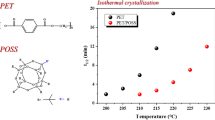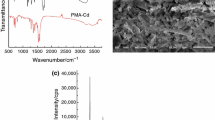Abstract
The poor solvent (hexanol)-induced crystallization of poly(ε-caprolactone) (PCL) ultrathin film on poly(vinylpyrrolidone) (PVPY) substrate is studied by using atomic force microscopy (AFM). PCL single crystals with screw dislocations melt and wet on PVPY substrate, forming a PCL ultrathin film with continuously changed film thickness. The effect of film thickness on the PCL crystallization morphology is directly observed by using the wetted PCL ultrathin film. Morphology transition from compact seaweed (CS) to fractal dendrite (FD) occurs with the decrease of the film thickness. A lot of dispersed FDs appear when PCL ultrathin film recrystallizes in the presence of minute amount of hexanol. We denote it as a “multi-nuclei” phenomenon. The content of residual hexanol is regulated by changing sample drying time under vacuum or sample melting temperature. Results show that the condition to obtain the highest nuclei density (or crystal density) is that the sample is dried under vacuum at room temperature for 24 h during sample preparation and melts at 200 °C for 10 min before recrystallization. If hexanol evaporates completely, the large area of FD grows continuously and no multi-nuclei phenomenon occurs. The interaction between PCL and PVPY substrate is excluded as the reason of the induction of multi-nuclei phenomenon. PVPY which blended in the PCL ultrathin film during the sample preparation is immiscible with PCL and inhibits the nucleation and crystallization of PCL. In this work, poor solvent provides us a new method to find nucleating agent for polymer thin films.





Similar content being viewed by others
References
Tashiro K, Yoshioka A (2002) Macromolecules 35:410–414
Yoshioka A, Yashiro K (2004) Macromolecules 37:467–472
Duming CJ, Rebenfeld L, Russel WB, Weigmann HD, Polym J (1986) Sci Part B Polym Phys 24:1341–1360
Liu J, Chen L, Gao B, Cao X, Han Y, Xie Z, Wang L (2013) J Mater Chem A 1:6216–6225
Miller S, Fanchini G, Lin Y, Li C, Chen C, Su W, Chhowalla M (2008) J Mater Chem 18:306–312
Sun Y, Han Y, Liu J (2013) Chinese Sci Bull 58:2767–2774
Chen HP, Hu S, Zang HD, Hu B, Dadmun M (2013) Adv Funct Mater 23:1701–1710
Mareau VH, Prud’homme RE (2005) Polymer 46:7255–7265
Schonherr H, Frank CW (2003) Macromolecules 36:1188–1198
Gopalan SA, Seo MH (2014) J Mater Chem A 2:2174–2186
Huo H, Yang Y, Zhao X (2014) CrystEngComm 16:1351–1358
Yang Y, Huo H, Polym J (2013) Sci Part B Polym Phys 51:1162–1174
Huo H, Yao X, Zhang Y, Li J, Shang Y, Jiang S (2013) Polym Eng Sci 53:125–133
Jiang Y, Yan D, Gao X, Han CC, Jin X, Li L, Wang Y, Chan C (2003) Macromolecules 36:3652–3655
Taguchi K, Miyaji H, Izumi K, Hoshino A, Miyamoto Y, Kokawa R (2002) J Macromol Sci B B41:1033–1042
Zhu DS, Liu YX, Chen EQ, Li M, Cheng SZ (2006) Acta Polym Sin 9:1125–1128
Qiao C, Jiang S, Ji X, An L (2013) Chinese J Polym Sci 31:1321–1328
Jin L, Zhang G, Zhai X, Ma Z, Zheng P, Wang W (2009) Polymer 50:6157–6165
Brener E, Muller-Krumbhaar H, Temkin D (1992) Europhys Lett 17:535–540
Sakai Y, Imai M, Kaji K, Tsuji M (1999) J Cryst Growth 203:244–254
Reiter G, Sommer JU (1998) Phys Rev Lett 80:3771–3774
Qiao C, Zhao J, Jiang S, Ji X, An L, Jiang B, Polym J (2005) Sci Part B Polym Phys 43:1303–1309
Maillard D, Prud’homme RE (2006) Macromolecules 39:4272–4275
Sanandaji N, Ovaskainen L, Gunnewiek MK, Vancso GJ, Hedenqvist MS, Yu S, Eriksson L, Roth SV, Gedde UW (2013) Polymer 54:1497–1503
Yang J, Liao Q, Zhou J, Jiang X, Wang X, Zhang Y, Jiang S, Yan S, Li L (2011) Macromolecules 44:3511–3516
Beekmans LGM, Vallee R, Vancso J (2002) Macromolecules 35:9383–9390
Yoon JG, Zin WC, Kim JH (2012) Polymer 53:2744–2750
Mareau VH, Prud’homme RE (2005) Macromolecules 38:398–408
Liu KJ, Jin M, La RX, Zhang J, Wang T, Zhang X (2014) Mater Lett 125:209–212
Huo H, Jiang S, An L, Feng J (2004) Macromolecules 37:2478–2483
Fukushima K, Tabuani D, Arena M, Gennari M, Camino G (2013) React Funct Polym 73:540–549
Huo H, Guo C, Zhou J, Zhao X (2014) Colloid Polym Sci 292:971–983
Marco C, Ellis G, Gomez MA, Arribas JM (2002) J Appl Polym Sci 84:2440–2450
Ye H, Tang Y, Xu J, Guo B (2013) Ind Eng Chem Res 52:10682–10689
Ciapetti G, Ambrosio L, Savarino L, Granchi D, Cenni E, Baldini N, Pagani S, Guizzardi S, Causa F, Giunti A (2003) Biomaterials 24:3815–3824
Ruelle B, Peeterbroeck S, Bittencourt C, Gorrasi G, Patimo G, Hecq M, Snyders R, De Pasquate S, Dubois P (2012) React Funct Polym 72:383–392
Phillips PJ, Rensch GJ, Taylor KDJ, Polym J (1987) Sci Part B Polym Phys 25:1725–1740
Phillips PJ, Rensch GJ, Polym J (1989) Sci Part B Polym Phys 27:155–173
You C, Shi X (2001) Polym Material Sci Eng 17:162–164
He M, Chen W, Dong X (1990) Polymer Physics. Fudan University Press, p.114-120
Kikkawa Y, Abe H, Iwata T, Inoue Y, Doi Y (2001) Biomacromolecules 2:940–945
Kikkawa Y, Abe H, Fujita M, Iwata T, Inoue Y, Doi Y (2003) Macromol Chem Phys 204:1822–1831
Izumi K, Ping G, Hashimoto M, Toda A, Miyaji H, Miyamoto Y (1997) Advances in the understanding of crystal growth mechanisms. Elsevier Science B. V, Amsterdam, p. 337–48
Kressler J, Wang C (1997) Langmuir 13:4407–4412
Maillard D, Prud’homme RE (2008) Macromolecules 41:1705–1712
Woo E, Park M, Jeong YG, Shin K (2012) J Appl Polym Sci 123:2558–2565
Napolitano S, Wubbenhorst M (2007) J Phys Conds Matter 19:205121
Author information
Authors and Affiliations
Corresponding author
Ethics declarations
The sources of financial funding and support
This work is supported by the National Natural Science Foundation of China Programs (20804005) and Beijing Higher Education Young Elite Teacher Project.
Conflict of interest
The authors declare that they have no competing interests.
Rights and permissions
About this article
Cite this article
Guo, C., Huo, H. Poor solvent as a nucleating agent to induce poly(ε-caprolactone) ultrathin film crystallization on poly(vinylpyrrolidone) substrate. Colloid Polym Sci 294, 767–776 (2016). https://doi.org/10.1007/s00396-015-3821-3
Received:
Revised:
Accepted:
Published:
Issue Date:
DOI: https://doi.org/10.1007/s00396-015-3821-3




